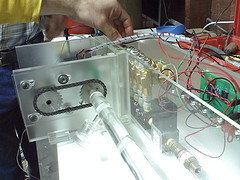Acrylic Pens
As with most handcrafted items, the starting material choice will dictate how the final product will take shape. When handcrafting pens, more specifically, there are several choices the pen turner can turn to. Besides wood, the pen crafter has alternative choices. One is a natural stone material processed specifically for pen turning. Lately, there is a combination of wood and plastic combined coming to the market for pen crafters to use.
The old standby for pen crafters is still one of the most viable choices, outside of wood. That choice is acrylic acetate formulations for pen blanks. Acrylics turn similar to the hardwoods that wood workers have been using and are available in an infinite combination of colors and designs. There are single color choices that are colored from white to coal black. There are vivid hues added to some colors to bring back designs that remind one of childhood, favorite school colors or just plain fantasy.
Pen crafters select their acrylic formulations from many different sources, or prepare their own. Preparing their own formulation takes considerable time, which takes time away from turning a pen, so many pen crafters will purchase blanks in the styles and colors they wish to use. Many will concentrate on one style, say, for example, neutral tones and hues. They may include subtle color striations throughout the blank or a complimenting dash of color throughout the pen blank. Many other pen turners will use more vivid color schemes and patterns for their pens.
No matter what design is chosen, most pen crafters will turn several types of pens. They will produce a twist pen, a pen with a twist off cap or one with a snap cap. The type of pen dictates the style the acrylic blank is turned. There may be bowed upper and lower barrels on some of the slimmer models of pens that provide a good grip, but will also highlight the color patterns and designs in the acrylic.
There are straight sided pens that are used in the larger barreled pens so that the pen is not over weighted and has excellent balance. Balance is key to a good solid pen. The pen must feel right and as one writes, and a well balanced pen makes writing a breeze. This balance can be achieved most effectively when using acrylics or resins as the pens’ material base starting choice. These blanks have relatively the same density throughout, so there is less likelihood of the pen crafter trying to balance out the pen while turning on the lathe.
Also included in the acrylic category are the newer poly resins and polymers that reflect light and provide the pen crafter the ability to use brass pen tubes and not having the brass show through the lighter colored pen blanks. As they are relatively new to the pen crafter, there are only a few designs and colors available for the pen turner to use. As more designs are introduced, pen crafters will begin using them more often.
The basic acrylic formulations are still the pen crafters best choice for turning pens on their lathes. Their ease of use, availability and infinite colors and color combinations, allow the pen crafter to work with acrylics, similarly as they do with wood.
© Paul Witmer 2010
Paul Witmer is a pharmaceutical engineering profssional and avid wood worker specializing in fine pens. Paul is also co-owner of www.WitmerEnterprises.com
Related Machining Acrylic Articles
